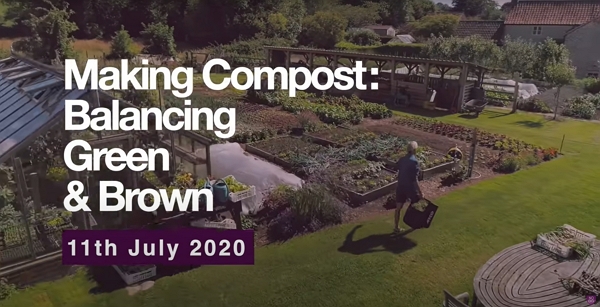Successful compost can be summarized by a good a good balance of green or brown. Let’s review the must-know with Charles.
Thanks to Charles Dowding for sharing his wisdom and knowledge! I wrote the following notes watching the video published on Charles Dowding’s channel. You can watch it using this YouTube link.
It’s difficult to look at it too scientifically about it and the quantity of the materials one is adding vary all the time.
No two gardens are the same. So the materials you will have won’t be the same as Charles or I add.
That’ll be perhaps broadly similar but you will always find subtle differences. So don’t worry too much about being precise.
Ratio of green and brown
The mix of green and brown should be at least half green and half brown. But what is green and what is brown?
Comment about carbon to nitrogen balance
It’s often talked about in books. And it confuses things because the proportion given is two parts of carbon to one part of nitrogen. So it’s more a ratio of 33% green to 66% of brown. Very few things are pure green and similarly to brown material.
Definition of green
What is mostly green? Here is a sample list:
- All fresh leaves
- Vegetable peels
- Kitchen waste
- Weed leaves
- Young tree leaves
- Fresh manure
- Coffee grounds
- Urine
Definition of brown
What is mostly brown? Here is a sample list:
- Woody materials
- Old stems
- Prunings
- Dry tree leaves
- Soil (in small quantity)
- Wood ash
- Paper
- Cardboard
What is OK to put diseases material on the compost heap
It’s OK to put on vegetable leaves with mildew, for example. For Charles, it doesn’t cause a problem to the finished product. He has used blighted potatoes leaves, rust of garlic or leeks and all went in the heap. For the case of blight, the disease needs living tissues and when the waste green of the plant goes on the heap, the disease will no longer persist.
Filling the heap
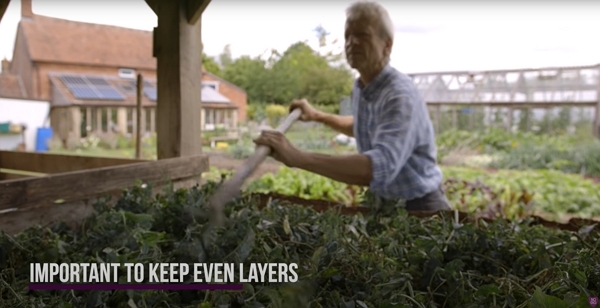 You can put seed on the heap, but put it in the middle where you get the most heat, warranting to kill the seeds. You can put on thistle in as well. A lot of myths, generally accepted, exist about what can’t and what can be put in the heap.
You can put seed on the heap, but put it in the middle where you get the most heat, warranting to kill the seeds. You can put on thistle in as well. A lot of myths, generally accepted, exist about what can’t and what can be put in the heap.
Once they’ve been repeated enough, then they start to enter the general belief.
Building in layers
Why should you fill your heap in layers? To get an even spread.
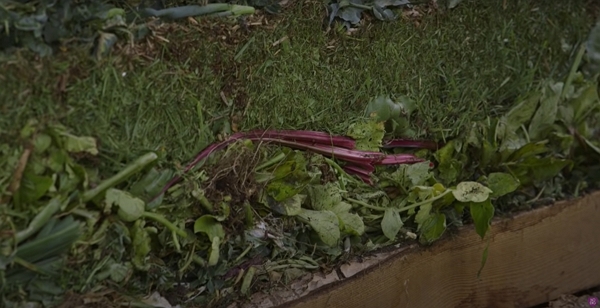 We don’t see very clearly the brown layers, but it’s there in the ratio stated above. We can see a lot of vegetable stems that contain more brown than green leaves. Also depending on seasons, you will have available a various amounts of green and brown. Spring is the height of the green season. Summer is a bit more balanced green and brown And then autumn is more brown material and finally winter is very brown.
We don’t see very clearly the brown layers, but it’s there in the ratio stated above. We can see a lot of vegetable stems that contain more brown than green leaves. Also depending on seasons, you will have available a various amounts of green and brown. Spring is the height of the green season. Summer is a bit more balanced green and brown And then autumn is more brown material and finally winter is very brown.
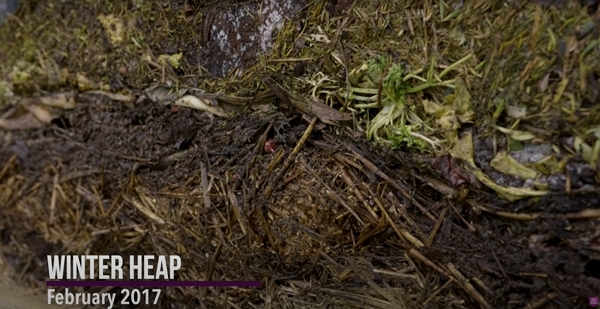 So you’ve got different seasons, you have different materials.
So you’ve got different seasons, you have different materials.
Why build a heap at all
A heap will hold the materials, it will hold the heat and it will make it tidier. Also, Charles has a lot of solids and it’s often said that a compost heat should have slated sides to allow some passenger in (insects, small animals, etc.). Air is a vital ingredient in compost making because that is what bacteria breathe on to live and multiply. And they do a lot of the breakdown: they’re what brings the heat in the heap. The brown material, especially larger pieces, will allow to have more air in the heap, helping the battery to do their job.
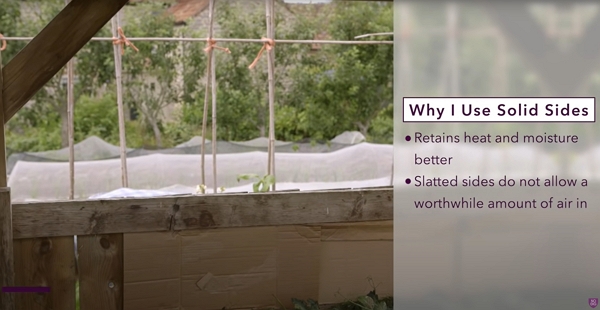 You would ask: why use solid sides to build a heap? Charles explains that it helps:
You would ask: why use solid sides to build a heap? Charles explains that it helps:
- retain the heat and moisture better
- slatted sides don’t allow a worthwhile amount of air in. They are lined inside with cardboard, so no air enters, moisture and warmth are retained as explained in this vlog.
Store brown
Expand Down
During spring and summer, you have less brown available. So store away leaves, for example. I’m currently _harvesting dead leaves, literally all I can get in my neighborhood. I will probably build some kind of heap just for the leaves so I can _sprinkle them into my compost in the making.
Point about weed roots
Bindweeds are big trouble for the gardeners. I know I have got a lot. Charles isn’t afraid to say that putting in even the roots in the heap is OK. And these roots aren’t indestructible. We give them too much credit. They seem invincible, but they’re not A weed root has only so much energy, so if you can keep it away from the light while it’ll try to grow, it’ll do so or it gets too hot and die from that. And as it tries to grow, it’s using up its energy and it withers at the end. Of course, don’t just put a lot on the heap and leave them to grow. So:
- cover them
- put them in the middle of the heap and heat will take care of them It’s the same for couch grass, perennial thistles.
Sizing your heap
If you’re like Charles, you could replicate on 1.5 m by 1.5 m heap structure, but you will need 3000 m² of land with a sizable vegetable garden and the lawn and edges. Otherwise, you need to find out your size by starting small. I don’t have a large garden nor access to lots of material. I would suggest to start with Charles’s pallets heap structure that are cheaper to make and smaller. And even if it’s still too big, cut pallets in half. That’s what I’m doing.
Finding material if you can’t produce enough
Like I said above, I personally harvest dead leaves. This year, I will try to harvest all I can. Use your vegetable waste, which supposes that you eat fresh food, not prepared meals… My family throws away 5 liters each day! And actually, it’s really difficult to get material sometimes unless you get very good at scrounging. So ask your neighbors. Put the words out around you! You might be surprised.
About temperature
Buy one of these thermometers in France, in the UK or in the US to measure the heat. You can make compost without heat, like leaf mold. Heat is just speeding up the process of decomposition. You should also watch the heat so it doesn’t go too much over 70 °C. Over that, you will use fungal activities. If you get over 70 °C, it usually happens as a flash of heat after adding new green material.
What about watering
It doesn’t apply to what Charles has put on the heap in this vlog, which was mostly green. Also, too much moisture removes air from the materials and bacteria can’t live in it. You need water if it’s quite dry or if you have got a lot of brown. But in Charles’s case, where he lives, it’s quite wet all year long, so the quality of his compost has increased from the roof over his heap.
Maintaining your heap
First, write when you start it. Also, when is it good to stop filling it? Well, as long as the levels keep lowering fast, you can keep filling it. You will notice very easily when it’s slowing. Next, you don’t need to turn often your compost, despite what you have heard. You always can, but it takes time to do so and isn’t it better to use this time to gather materials instead? Charles performs only one turning. Go for it now!
